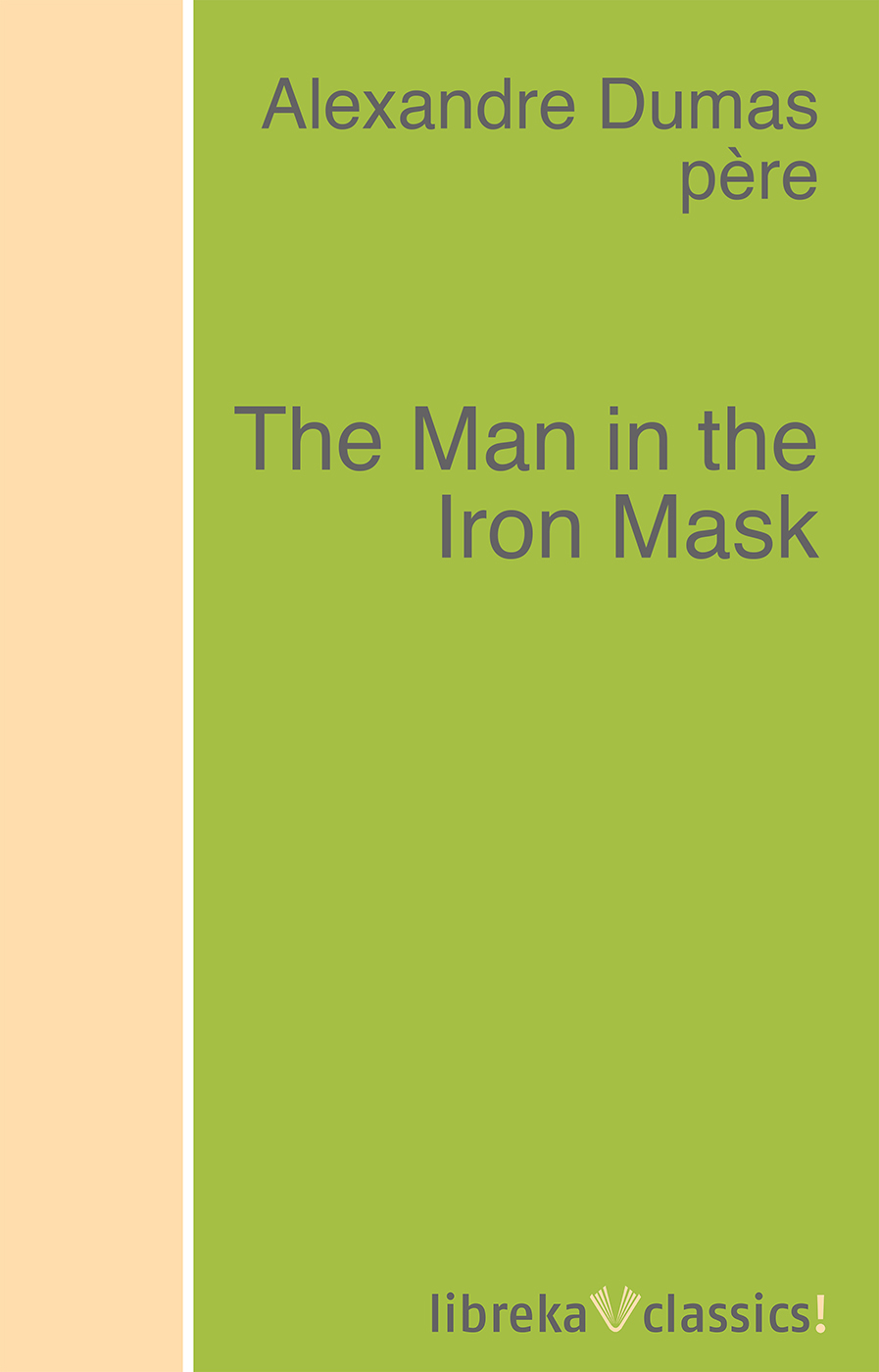
Полная версия
The Man in the Iron Mask


Titel: The Man in the Iron Mask
von ca. 337-422 Faxian, Sir Samuel White Baker, Sax Rohmer, Bernardin de Saint-Pierre, Maria Edgeworth, Saint Sir Thomas More, Herodotus, L. Mühlbach, Herbert Allen Giles, G. K. Chesterton, Algernon Charles Swinburne, Rudyard Kipling, A. J. O'Reilly, William Bray, O. Henry, graf Leo Tolstoy, Anonymous, Lewis Wallace, Johann Wolfgang von Goethe, Edgar Allan Poe, Jack London, Elizabeth Cleghorn Gaskell, Jules Verne, Frank Frankfort Moore, Susan Fenimore Cooper, Anthony Trollope, Henry James, T. Smollett, Thomas Burke, Emma Goldman, George Eliot, Henry Rider Haggard, Baron Thomas Babington Macaulay Macaulay, A. Maynard Barbour, Edmund Burke, Gerold K. Rohner, Bernard Shaw, Sir Joshua Reynolds, Bret Harte, Nathaniel Hawthorne, Jerome K. Jerome, Isabella L. Bird, Christoph Martin Wieland, Rainer Maria Rilke, Ludwig Anzengruber, Freiherr von Ludwig Achim Arnim, G. Harvey Ralphson, John Galsworthy, George Sand, Pierre Loti, Fyodor Dostoyevsky, Giambattista Basile, Homer, John Webster, P. G. Wodehouse, William Shakespeare, Edward Payson Roe, Sir Walter Raleigh, Victor [pseud.] Appleton, Arnold Bennett, James Fenimore Cooper, James Hogg, Richard Harding Davis, Ernest Thompson Seton, William MacLeod Raine, E. Phillips Oppenheim, Maksim Gorky, Henrik Ibsen, George MacDonald, Sir Max Beerbohm, Lucy Larcom, Various, Sir Robert S. Ball, Charles Darwin, Charles Reade, Adelaide Anne Procter, Joseph Conrad, Joel Chandler Harris, Joseph Crosby Lincoln, Alexander Whyte, Kate Douglas Smith Wiggin, James Lane Allen, Richard Jefferies, Honoré de Balzac, Wilhelm Busch, General Robert Edward Lee, Charles Dickens, Wilkie Collins, David Cory, Booth Tarkington, George Rawlinson, Sir Arthur Conan Doyle, Dinah Maria Mulock Craik, Christopher Evans, Thomas Henry Huxley, Mary Roberts Rinehart, Erskine Childers, Alice Freeman Palmer, Florence Converse, William Congreve, Stephen Crane, Madame de La Fayette, United States. Army. Corps of Engineers. Manhattan District, Willa Sibert Cather, Anna Katharine Green, Oliver Wendell Holmes, Charlotte M. Brame, Alphonse Daudet, Booker T. Washington, Clemens Brentano, Sylvester Mowry, Geoffrey Chaucer, Ellen Anderson Gholson Glasgow, Gail Hamilton, William Roscoe Thayer, Margaret Wade Campbell Deland, Rafael Sabatini, Archibald Henderson, Albert Payson Terhune, George Wharton James, Padraic Colum, James MacCaffrey, John Albert Macy, Annie Sullivan, Helen Keller, Walter Pater, Sir Richard Francis Burton, Baron de Jean-Baptiste-Antoine-Marcelin Marbot, Aristotle, Gustave Flaubert, 12th cent. de Troyes Chrétien, Valentine Williams, Thomas Wentworth Higginson, Alexandre Dumas fils, John Gay, Andrew Lang, Hester Lynch Piozzi, Jeffery Farnol, Alexander Pope, George Henry Borrow, Mark Twain, Francis Bacon, Margaret Pollock Sherwood, Henry Walter Bates, Thornton W. Burgess, Edmund G. Ross, William Alexander Linn, Voltaire, Giles Lytton Strachey, Henry Ossian Flipper, Émile Gaboriau, Arthur B. Reeve, Hugh Latimer, Baron Edward Bulwer Lytton Lytton, Benito Pérez Galdós, Robert Smythe Hichens, Niccolò Machiavelli, Prosper Mérimée, Ivan Sergeevich Turgenev, Anatole Cerfberr, Jules François Christophe, Victor Cherbuliez, Edgar B. P. Darlington, David Grayson, Mihai Nadin, Helen Beecher Long, Plutarch, Harriet Beecher Stowe, Margaret E. Sangster, Herman Melville, John Keats, Fannie Isabel Sherrick, Maurice Baring, William Terence Kane, Mary Russell Mitford, Henry Drummond, Rabindranath Tagore, Hubert Howe Bancroft, Charlotte Mary Yonge, William Dean Howells, Jesse F. Bone, Basil Hall Chamberlain, William Makepeace Thackeray, Samuel Butler, Frances Hodgson Burnett, E. Prentiss, Sir Walter Scott, Alexander K. McClure, David Livingstone, Bram Stoker, Victor Hugo, Patañjali, Amelia Ruth Gere Mason, Bertrand Russell, Alfred Russel Wallace, Molière, Robert Louis Stevenson, Simona Sumanaru, Michael Hart, Edmund Gosse, Samuel Smiles, Pierre Corneille, Clarence Edward Mulford, Mrs. Oliphant, George Pope Morris, Aristophanes, baron de Etienne-Léon Lamothe-Langon, William Morris, Henry David Thoreau, E. C. Bentley, Samuel Taylor Coleridge, Hippolyte Taine, Pedro Calderón de la Barca, John Philip Sousa, Wilhelm Grimm, Jacob Grimm, William Gardner, J. M. Judy, E. M. Forster, Percival Lowell, Alexandre Dumas père, William Greenwood, John Dryden, William T. Sherman, John Kendrick Bangs, Burton Egbert Stevenson, Eugene Wood, John Arbuthnot, Sir Richard Steele, Sir George Otto Trevelyan, William Charles Henry Wood, Marcel Proust, Philip Henry Sheridan, Abraham Lincoln, John Pinkerton, Thomas Hardy, Gotthold Ephraim Lessing, Oliver Goldsmith, Freiherr von der Friedrich Trenck, Eugene Field, Charles Dudley Warner, Andrew Everett Durham, Emily Dickinson, Emperor of Rome Marcus Aurelius, Edgar Wallace, Annie Roe Carr, Eleanor Stackhouse Atkinson, George McKinnon Wrong, Heinrich Zschokke, Harold Howland, Grace S. Richmond, Louisa May Alcott, Thomas Edwards, William Kirby
ISBN 978-3-7429-2657-9
Alle Rechte vorbehalten.
Es ist ohne vorherige schriftliche Erlaubnis nicht gestattet, dieses Werk im Ganzen oder in Teilen zu vervielfältigen oder zu veröffentlichen.
THE MAN IN THE IRON MASK
by Alexandre Dumas
THE PROJECT GUTENBERG EDITOR'S NOTE TO THE PG D'ARTAGNAN SERIES
LINKED INDEX OF PROJECT GUTENBERG VOLUMES:
DOWNLOAD INSTRUCTIONSContents
Transcriber's Notes:
Introduction:
Chapter I. The Prisoner. Chapter II. How Mouston Had Become Fatter without Giving Porthos Notice Thereof Chapter III. Who Messire Jean Percerin Was. Chapter IV. The Patterns. Chapter V. Where, Probably, Moliere Obtained His First Idea of the Bourgeois Gentilhomme. Chapter VI. The Bee-Hive, the Bees, and the Honey. Chapter VII. Another Supper at the Bastile. Chapter VIII. The General of the Order. Chapter IX. The Tempter. Chapter X. Crown and Tiara. Chapter XI. The Chateau de Vaux-le-Vicomte. Chapter XII. The Wine of Melun. Chapter XIII. Nectar and Ambrosia. Chapter XIV. A Gascon, and a Gascon and a Half. Chapter XV. Colbert. Chapter XVI. Jealousy. Chapter XVII. High Treason. Chapter XVIII. A Night at the Bastile. Chapter XIX. The Shadow of M. Fouquet. Chapter XX. The Morning. Chapter XXI. The King's Friend. Chapter XXII. Showing How the Countersign Was Respected at the Bastile. Chapter XXIII. The King's Gratitude. Chapter XXIV. The False King. Chapter XXV. In Which Porthos Thinks He Is Pursuing a Duchy. Chapter XXVI. The Last Adieux. Chapter XXVII. Monsieur de Beaufort. Chapter XXVIII. Preparations for Departure. Chapter XXIX. Planchet's Inventory. Chapter XXX. The Inventory of M. de Beaufort. Chapter XXXI. The Silver Dish. Chapter XXXII. Captive and Jailers. Chapter XXXIII. Promises. Chapter XXXIV. Among Women. Chapter XXXV. The Last Supper. Chapter XXXVI. In M. Colbert's Carriage. Chapter XXXVII. The Two Lighters. Chapter XXXVIII. Friendly Advice. Chapter XXXIX. How the King, Louis XIV., Played His Little Part. Chapter XL: The White Horse and the Black. Chapter XLI. In Which the Squirrel Falls,—the Adder Flies. Chapter XLII. Belle-Ile-en-Mer. Chapter XLIII. Explanations by Aramis. Chapter XLIV. Result of the Ideas of the King, and the Ideas of D'Artagnan. Chapter XLV. The Ancestors of Porthos. Chapter XLVI. The Son of Biscarrat. Chapter XLVII. The Grotto of Locmaria. Chapter XLVIII. The Grotto. Chapter XLIX. An Homeric Song. Chapter L: The Death of a Titan. Chapter LI. Porthos's Epitaph. Chapter LII. M. de Gesvres's Round. Chapter LIII. King Louis XIV. Chapter LIV. M. Fouquet's Friends. Chapter LV. Porthos's Will. Chapter LVI. The Old Age of Athos. Chapter LVII. Athos's Vision. Chapter LVIII. The Angel of Death. Chapter LIX. The Bulletin. Chapter LX. The Last Canto of the Poem. Epilogue.Footnotes
Transcriber's Notes:
As you may be aware, Project Gutenberg has been involved with the writings of both the Alexandre Dumases for some time now, and since we get a few questions about the order in which the books should be read, and in which they were published, these following comments should hopefully help most of our readers.
***
The Vicomte de Bragelonne is the final volume of D'Artagnan Romances: it is usually split into three or four parts, and the final portion is entitled The Man in the Iron Mask. The Man in the Iron Mask we're familiar with today is the last volume of the four-volume edition. [Not all the editions split them in the same manner, hence some of the confusion...but wait...there's yet more reason for confusion.]
We intend to do ALL of The Vicomte de Bragelonne, split into four etexts entitled The Vicomte de Bragelonne, Ten Years Later, Louise de la Valliere, and The Man in the Iron Mask.
One thing that may be causing confusion is that the etext we have now, entitled Ten Years Later, says it's the sequel to The Three Musketeers. While this is technically true, there's another book, Twenty Years After, that comes between. The confusion is generated by the two facts that we published Ten Years Later BEFORE we published Twenty Years After, and that many people see those titles as meaning Ten and Twenty Years "After" the original story...however, this is why the different words "After" and "Later"...the Ten Years "After" is ten years after the Twenty Years later...as per history. Also, the third book of the D'Artagnan Romances, while entitled The Vicomte de Bragelonne, has the subtitle Ten Years Later. These two titles are also given to different volumes: The Vicomte de Bragelonne can refer to the whole book, or the first volume of the three or four-volume editions. Ten Years Later can, similarly, refer to the whole book, or the second volume of the four-volume edition. To add to the confusion, in the case of our etexts, it refers to the first 104 chapters of the whole book, covering material in the first and second etexts in the new series. Here is a guide to the series which may prove helpful:
The Three Musketeers: Etext 1257—First book of the D'Artagnan Romances. Covers the years 1625-1628.
Twenty Years After: Etext 1259—Second book of the D'Artagnan Romances. Covers the years 1648-1649. [Third in the order that we published, but second in time sequence!!!]
Ten Years Later: Etext 1258—First 104 chapters of the third book of the D'Artagnan Romances. Covers the years 1660-1661.
The Vicomte de Bragelonne: Etext 2609 (first in the new series)—First 75 chapters of the third book of the D'Artagnan Romances. Covers the year 1660.
Ten Years Later: Etext 2681 (second in the new series)—Chapters 76-140 of that third book of the D'Artagnan Romances. Covers the years 1660-1661. [In this particular editing of it]
Louise de la Valliere: Etext 2710 (third in the new series)—Chapters 141-208 of the third book of the D'Artagnan Romances. Covers the year 1661.
The Man in the Iron Mask: Etext 2759 (our next text)—Chapters 209-269 of the third book of the D'Artagnan Romances. Covers the years 1661-1673.
Here is a list of the other Dumas Etexts we have published so far:
Sep 1999 La Tulipe Noire, by Alexandre Dumas[Pere#6/French][tlpnrxxx.xxx]1910 This is an abridged edition in French, also see our full length English Etext Jul 1997 The Black Tulip, by Alexandre Dumas[Pere][Dumas#1][tbtlpxxx.xxx] 965 Jan 1998 The Count of Monte Cristo by Alexandre Dumas[Pere][crstoxxx.xxx]1184
Many thanks to Dr. David Coward, whose editions of the D'Artagnan Romances have proved an invaluable source of information.
Introduction:
In the months of March-July in 1844, in the magazine Le Siecle, the first portion of a story appeared, penned by the celebrated playwright Alexandre Dumas. It was based, he claimed, on some manuscripts he had found a year earlier in the Bibliotheque Nationale while researching a history he planned to write on Louis XIV. They chronicled the adventures of a young man named D'Artagnan who, upon entering Paris, became almost immediately embroiled in court intrigues, international politics, and ill-fated affairs between royal lovers. Over the next six years, readers would enjoy the adventures of this youth and his three famous friends, Porthos, Athos, and Aramis, as their exploits unraveled behind the scenes of some of the most momentous events in French and even English history.
Eventually these serialized adventures were published in novel form, and became the three D'Artagnan Romances known today. Here is a brief summary of the first two novels:
The Three Musketeers (serialized March—July, 1844): The year is 1625. The young D'Artagnan arrives in Paris at the tender age of 18, and almost immediately offends three musketeers, Porthos, Aramis, and Athos. Instead of dueling, the four are attacked by five of the Cardinal's guards, and the courage of the youth is made apparent during the battle. The four become fast friends, and, when asked by D'Artagnan's landlord to find his missing wife, embark upon an adventure that takes them across both France and England in order to thwart the plans of the Cardinal Richelieu. Along the way, they encounter a beautiful young spy, named simply Milady, who will stop at nothing to disgrace Queen Anne of Austria before her husband, Louis XIII, and take her revenge upon the four friends.
Twenty Years After (serialized January—August, 1845): The year is now 1648, twenty years since the close of the last story. Louis XIII has died, as has Cardinal Richelieu, and while the crown of France may sit upon the head of Anne of Austria as Regent for the young Louis XIV, the real power resides with the Cardinal Mazarin, her secret husband. D'Artagnan is now a lieutenant of musketeers, and his three friends have retired to private life. Athos turned out to be a nobleman, the Comte de la Fere, and has retired to his home with his son, Raoul de Bragelonne. Aramis, whose real name is D'Herblay, has followed his intention of shedding the musketeer's cassock for the priest's robes, and Porthos has married a wealthy woman, who left him her fortune upon her death. But trouble is stirring in both France and England. Cromwell menaces the institution of royalty itself while marching against Charles I, and at home the Fronde is threatening to tear France apart. D'Artagnan brings his friends out of retirement to save the threatened English monarch, but Mordaunt, the son of Milady, who seeks to avenge his mother's death at the musketeers' hands, thwarts their valiant efforts. Undaunted, our heroes return to France just in time to help save the young Louis XIV, quiet the Fronde, and tweak the nose of Cardinal Mazarin.
The third novel, The Vicomte de Bragelonne (serialized October, 1847—January, 1850), has enjoyed a strange history in its English translation. It has been split into three, four, or five volumes at various points in its history. The five-volume edition generally does not give titles to the smaller portions, but the others do. In the three-volume edition, the novels are entitled The Vicomte de Bragelonne, Louise de la Valliere, and The Man in the Iron Mask. For the purposes of this etext, I have chosen to split the novel as the four-volume edition does, with these titles: The Vicomte de Bragelonne, Ten Years Later, Louise de la Valliere, and The Man in the Iron Mask. In the first three etexts:
The Vicomte de Bragelonne (Etext 2609): It is the year 1660, and D'Artagnan, after thirty-five years of loyal service, has become disgusted with serving King Louis XIV while the real power resides with the Cardinal Mazarin, and has tendered his resignation. He embarks on his own project, that of restoring Charles II to the throne of England, and, with the help of Athos, succeeds, earning himself quite a fortune in the process. D'Artagnan returns to Paris to live the life of a rich citizen, and Athos, after negotiating the marriage of Philip, the king's brother, to Princess Henrietta of England, likewise retires to his own estate, La Fere. Meanwhile, Mazarin has finally died, and left Louis to assume the reigns of power, with the assistance of M. Colbert, formerly Mazarin's trusted clerk. Colbert has an intense hatred for M. Fouquet, the king's superintendent of finances, and has resolved to use any means necessary to bring about his fall. With the new rank of intendant bestowed on him by Louis, Colbert succeeds in having two of Fouquet's loyal friends tried and executed. He then brings to the king's attention that Fouquet is fortifying the island of Belle-Ile-en-Mer, and could possibly be planning to use it as a base for some military operation against the king. Louis calls D'Artagnan out of retirement and sends him to investigate the island, promising him a tremendous salary and his long-promised promotion to captain of the musketeers upon his return. At Belle-Isle, D'Artagnan discovers that the engineer of the fortifications is, in fact, Porthos, now the Baron du Vallon, and that's not all. The blueprints for the island, although in Porthos's handwriting, show evidence of another script that has been erased, that of Aramis. D'Artagnan later discovers that Aramis has become the bishop of Vannes, which is, coincidentally, a parish belonging to M. Fouquet. Suspecting that D'Artagnan has arrived on the king's behalf to investigate, Aramis tricks D'Artagnan into wandering around Vannes in search of Porthos, and sends Porthos on an heroic ride back to Paris to warn Fouquet of the danger. Fouquet rushes to the king, and gives him Belle-Isle as a present, thus allaying any suspicion, and at the same time humiliating Colbert, just minutes before the usher announces someone else seeking an audience with the king.
Ten Years Later (Etext 2681): As 1661 approaches, Princess Henrietta of England arrives for her marriage, and throws the court of France into complete disorder. The jealousy of the Duke of Buckingham, who is in love with her, nearly occasions a war on the streets of Le Havre, thankfully prevented by Raoul's timely and tactful intervention. After the marriage, though, Monsieur Philip becomes horribly jealous of Buckingham, and has him exiled. Before leaving, however, the duke fights a duel with M. de Wardes at Calais. De Wardes is a malicious and spiteful man, the sworn enemy of D'Artagnan, and, by the same token, that of Athos, Aramis, Porthos, and Raoul as well. Both men are seriously wounded, and the duke is taken back to England to recover. Raoul's friend, the Comte de Guiche, is the next to succumb to Henrietta's charms, and Monsieur obtains his exile as well, though De Guiche soon effects a reconciliation. But then the king's eye falls on Madame Henrietta during the comte's absence, and this time Monsieur's jealousy has no recourse. Anne of Austria intervenes, and the king and his sister-in-law decide to pick a young lady with whom the king can pretend to be in love, the better to mask their own affair. They unfortunately select Louise de la Valliere, Raoul's fiancee. While the court is in residence at Fontainebleau, the king unwitting overhears Louise confessing her love for him while chatting with her friends beneath the royal oak, and the king promptly forgets his affection for Madame. That same night, Henrietta overhears, at the same oak, De Guiche confessing his love for her to Raoul. The two embark on their own affair. A few days later, during a rainstorm, Louis and Louise are trapped alone together, and the whole court begins to talk of the scandal while their love affair blossoms. Aware of Louise's attachment, the king arranges for Raoul to be sent to England for an indefinite period.
Meanwhile, the struggle for power continues between Fouquet and Colbert. Although the Belle-Isle plot backfired, Colbert prompts the king to ask Fouquet for more and more money, and without his two friends to raise it for him, Fouquet is sorely pressed. The situation gets so bad that his new mistress, Madame de Belliere, must resort to selling all her jewels and her gold and silver plate. Aramis, while this is going on, has grown friendly with the governor of the Bastile, M. de Baisemeaux, a fact that Baisemeaux unwittingly reveals to D'Artagnan while inquiring of him as to Aramis's whereabouts. This further arouses the suspicions of the musketeer, who was made to look ridiculous by Aramis. He had ridden overnight at an insane pace, but arrived a few minutes after Fouquet had already presented Belle-Isle to the king. Aramis learns from the governor the location of a mysterious prisoner, who bears a remarkable resemblance to Louis XIV—in fact, the two are identical. He uses the existence of this secret to persuade a dying Franciscan monk, the general of the society of the Jesuits, to name him, Aramis, the new general of the order. On Aramis's advice, hoping to use Louise's influence with the king to counteract Colbert's influence, Fouquet also writes a love letter to La Valliere, unfortunately undated. It never reaches its destination, however, as the servant ordered to deliver it turns out to be an agent of Colbert's.
Louise de la Valliere (Etext 2710): Believing D'Artagnan occupied at Fontainebleau and Porthos safely tucked away at Paris, Aramis holds a funeral for the dead Franciscan—but in fact, Aramis is wrong in both suppositions. D'Artagnan has left Fontainebleau, bored to tears by the fetes, retrieved Porthos, and is visiting the country-house of Planchet, his old lackey. This house happens to be right next door to the graveyard, and upon observing Aramis at this funeral, and his subsequent meeting with a mysterious hooded lady, D'Artagnan, suspicions aroused, resolves to make a little trouble for the bishop. He presents Porthos to the king at the same time as Fouquet presents Aramis, thereby surprising the wily prelate. Aramis's professions of affection and innocence do only a little to allay D'Artagnan's concerns, and he continues to regard Aramis's actions with a curious and wary eye. Meanwhile, much to his delight, Porthos is invited to dine with the king as a result of his presentation, and with D'Artagnan's guidance, manages to behave in such a manner as to procure the king's marked favor.








